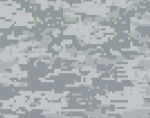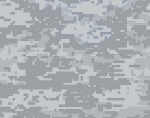Good Day,
I am a flexo graphics coordinator. 90% of our work is linework and some screenwork. Sometimes we will get process print jobs, but not a whole lot.
I have a customer that wants a camouflage pattern on their product. The design sent to me has the pattern in 3 separate GREY PMS colors (427, 428, 429).
I informed the customer that the trapping on this may produce undesirable results. Something like a puzzle pattern as opposed to the texture they were looking for.
I informed them the best way to print this would be process print but that would add more colors to their design.
I gave them an alternative that had the lightest grey with screens of black on top. We sent them a press printed proof and they are now questioning the outcome.
They want each color to look closer to their PMS alternatives.
I have tried different variations of screening and/or stroking the PMS colors, but all attempts have that puzzle pattern look.
My question is,
Is there something I am overlooking? Is there a different option I am not considering?
Thank you for any assistance.
EDIT:
View attachment PrePress vs JPGS.pdf
I am a flexo graphics coordinator. 90% of our work is linework and some screenwork. Sometimes we will get process print jobs, but not a whole lot.
I have a customer that wants a camouflage pattern on their product. The design sent to me has the pattern in 3 separate GREY PMS colors (427, 428, 429).
I informed the customer that the trapping on this may produce undesirable results. Something like a puzzle pattern as opposed to the texture they were looking for.
I informed them the best way to print this would be process print but that would add more colors to their design.
I gave them an alternative that had the lightest grey with screens of black on top. We sent them a press printed proof and they are now questioning the outcome.
They want each color to look closer to their PMS alternatives.
I have tried different variations of screening and/or stroking the PMS colors, but all attempts have that puzzle pattern look.
My question is,
Is there something I am overlooking? Is there a different option I am not considering?
Thank you for any assistance.
EDIT:
View attachment PrePress vs JPGS.pdf
Attachments
Last edited:












